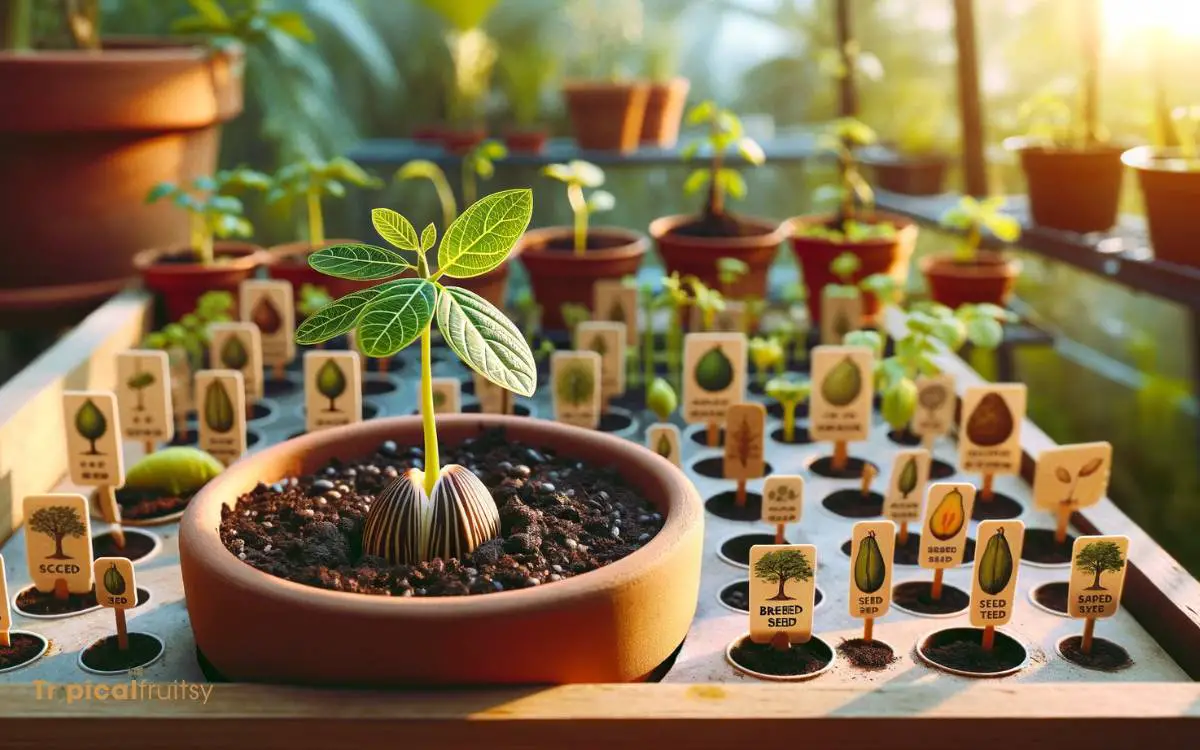How to Grow a Breadfruit Tree? 4 Easy Steps!
Growing a breadfruit tree (Artocarpus altilis) successfully involves selecting an appropriate location, ensuring proper soil conditions, regular maintenance, and understanding the tree’s growth and fruiting patterns.
It requires a warm climate, consistent watering, and protection from harsh elements.
The breadfruit tree is a tropical plant that thrives in conditions similar to its native South Pacific environment.
Here are some quick steps:
Nurture your breadfruit tree with care, and it will reward you with an abundance of nutritious fruit for years to come.

Key Takeaway
Understanding Breadfruit Trees
The breadfruit tree (Artocarpus altilis) is a tropical perennial that yields a starchy, nutrient-rich fruit, integral to various cuisines and cultures around the globe.
Originating from the Malay Peninsula and through the Pacific Islands, this species thrives in warm, humid climates and is typically found in altitudes ranging from sea level to 650 meters.
For optimal growth, breadfruit trees require well-drained, fertile soils with a pH between 6.1 and 6.7. It is imperative to maintain a regular watering schedule during the tree’s early development phase, ensuring a deep root system.
Full sunlight is crucial, although young plants benefit from partial shade. Successful cultivation also involves strategic pruning to facilitate air circulation and light penetration, essential for the tree’s prolific fruiting.
Step 1: Choosing the Right Location

Following an understanding of the breadfruit tree’s basic requirements, selecting an ideal location is the next critical step for ensuring its successful cultivation.
The site must meet specific environmental conditions to facilitate the tree’s growth and productivity.
As a tropical species, Artocarpus altilis thrives in warm and humid climates, with ample rainfall and well-drained soil.
The location should also provide sufficient space for the tree’s large canopy and root system to expand without constraints.
Consider the following location attributes:
- Ample Sunshine: Breadfruit trees require full sunlight for optimal growth.
- Protection from Winds: A sheltered area prevents damage to the tree’s structure.
- Soil Quality: Fertile, loamy soil with good drainage supports healthy root development.
- Space for Growth: Ensure adequate room for the tree’s mature size to avoid future transplantation.
Step 2: Planting Your Breadfruit Sapling

Once an ideal location has been established, several breadfruit saplings should be planted to ensure at least one successful growth. Planting should occur during the wet season to facilitate root establishment and reduce water stress.
Dig a hole twice as wide and of equal depth to the sapling’s root ball to encourage root expansion. Introduce a mix of native soil and compost into the hole to enhance nutrient availability.
Carefully place the sapling in the center, ensuring the base of the trunk is level with the soil surface to prevent water pooling. Backfill the hole, gently tamping down the soil to remove air pockets.
Immediate and consistent irrigation post-planting is crucial to support the acclimatization process. This leads us to the subsequent necessity of diligent care for your breadfruit tree to thrive.
Step 3: Caring for Your Tree

Ensure proper growth and health of your breadfruit tree by consistently monitoring and adjusting watering, fertilization, and pruning practices.
Breadfruit trees thrive in well-drained soils with high organic matter content, requiring regular irrigation during dry periods to maintain a consistent level of soil moisture.
Fertilization should be approached with precision, utilizing a balanced N-P-K (Nitrogen-Phosphorus-Potassium) fertilizer in accordance with the tree’s growth stage and soil nutrient profile.
- Meticulously manage moisture levels to prevent root rot and ensure a robust root system.
- Tailor fertilization to the tree’s life cycle stages, promoting optimal growth and fruit production.
- Conduct strategic pruning to shape the tree and enhance sunlight penetration and air circulation.
- Monitor for pests and diseases, implementing integrated pest management techniques to safeguard your tree.
Step 4: Harvesting and Using Breadfruit

Harvesting breadfruit at the optimal maturity ensures the highest quality and flavor for both culinary and cultural uses.
The maturation of breadfruit is indicated by a slight softening of the fruit and a change in the skin texture and color.
To ascertain the precise moment for harvest, one should monitor the fruit’s development closely, as the window for optimal harvest is relatively narrow.
Upon reaching maturity, the fruit should be carefully twisted from the stem to prevent damage to the tree’s productive structures.
Post-harvest, breadfruit can be utilized in a multitude of ways, ranging from traditional dishes to modern culinary innovations.
It can be consumed raw, roasted, boiled, or fried, and its starchy texture lends itself well to being processed into flour. This versatility makes breadfruit a valuable and sustainable food source in tropical agriculture.
How to Grow a Breadfruit Tree from Seed

Growing a breadfruit tree from seed can be a rewarding gardening project, but it’s important to note that breadfruit trees are usually propagated from root cuttings or suckers, as most cultivated varieties do not produce seeds.
However, if you have a seeded variety of breadfruit, here’s how you can grow it:
Requirements
- Breadfruit seed
- Potting soil
- A pot with drainage holes
- Warm, tropical-like environment (Breadfruit trees thrive in such conditions)
Steps to Grow a Breadfruit Tree from Seed
- Obtain a Fresh Seed: Ensure your breadfruit seed is fresh and obtained from a ripe fruit. The viability of breadfruit seeds decreases rapidly, so plant it as soon as possible after extraction.
- Prepare the Seed: Clean the seed gently to remove any attached fruit pulp. Avoid damaging the seed during cleaning.
- Seed Soaking (Optional): Soak the seed in water for up to 24 hours. This can help to expedite germination.
- Pot Preparation: Fill a pot with well-draining potting soil. Breadfruit trees prefer rich, organic, and well-drained soil. The pot should be large enough to accommodate the seedling’s initial growth.
- Plant the Seed: Plant the seed about 1-2 inches deep in the soil. Make sure the wider end of the seed is placed downward.
- Ideal Conditions: Breadfruit seeds need warm conditions to germinate. Maintain a consistent temperature of about 80-90°F (27-32°C). Ensure the seed gets plenty of indirect sunlight.
- Watering: Keep the soil consistently moist but not waterlogged. Over-watering can lead to root rot.
- Germination: Breadfruit seeds can take anywhere from 2-4 weeks to germinate, depending on conditions.
- Care After Germination: Once the seedling emerges, continue to provide it with indirect sunlight and keep the soil moist. As it grows, you may need to transplant it to a larger pot or directly into the ground, depending on your local climate.
- Transplanting: If your climate permits, transplant the tree outdoors in a sunny, well-draining location. Breadfruit trees require a lot of space as they can grow quite large.
- Ongoing Care: Water the tree regularly and apply organic fertilizer as needed. Protect the tree from cold temperatures and frost, as it is a tropical plant.
Additional Tips
- Patience is Key: Breadfruit trees grown from seed can take several years to mature and bear fruit.
- Pest and Disease Management: Be vigilant about pests and diseases. Regularly inspect your tree and treat any issues promptly.
- Pruning: Prune the tree to manage its size and shape, and to remove any dead or diseased branches.
Growing a breadfruit tree can be a lengthy process, especially from seed, and success depends greatly on the climate and care given to the plant.
If you’re in a non-tropical region, it’s crucial to provide a greenhouse or similar environment to mimic the tree’s natural growing conditions.
Can You Grow a Breadfruit Tree in a Cold Climate?
Yes, it is possible to grow a breadfruit tree in a cold climate with proper care and attention. The breadfruit tree explanation lies in its ability to thrive in warm, tropical climates, but with the right protection from frost and cold temperatures, it can still grow and produce fruit in colder regions.
How Long Does a Breadfruit Tree Take to Grow

A breadfruit tree (Artocarpus altilis) can take several years to reach maturity and start producing fruit.
The exact time it takes for a breadfruit tree to grow and bear fruit can vary depending on various factors, including the specific variety of breadfruit, growing conditions, and care provided to the tree.
Here is a general timeline for the growth of a breadfruit tree:
Germination and Seedling Stage: Breadfruit trees can be grown from seeds, but this method can take longer to produce fruit. When grown from seeds, it typically takes about 1 to 2 years for a breadfruit tree to reach the seedling stage.
During this period, the tree will develop its initial set of leaves and establish its root system.
Growth to Sapling: Once the breadfruit tree reaches the sapling stage, it can take another 2 to 4 years to grow into a young tree with a more significant trunk and branches. The exact timing can vary based on factors like soil quality, climate, and care.
Maturation and Fruit Production: Breadfruit trees typically begin to produce fruit when they are around 4 to 8 years old.
Again, this timeline can be influenced by various factors, including the tree’s health, environmental conditions, and proper care, such as adequate watering, fertilization, and pruning.
It’s important to note that some breadfruit varieties may take longer to mature and produce fruit than others.
Additionally, grafting or vegetative propagation methods can be used to speed up the fruit-bearing process, allowing younger trees to produce fruit sooner than those grown from seeds.
In summary, a breadfruit tree can take anywhere from 4 to 8 years or more to reach maturity and start producing fruit. The actual time may vary based on the specific circumstances of the tree’s growth.
Conclusion
The cultivation of breadfruit trees stands as a testament to the ingenuity of agricultural practices, capable of providing a cornucopia of nutritious fruits.
Meticulous care, from site selection to the precise timing of harvest, ensures a bountiful yield.
This arboreal marvel, once nurtured, becomes an almost mythical provider of sustenance, with the potential to single-handedly bolster food security. Its successful growth is a triumph of horticultural skill and a celebration of botanical potential.






